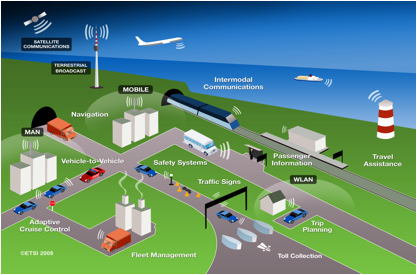![]()
Project
Title: An
information-centric IoT infrastructure for pollution
monitoring and sustainable traffic planning
Acknowledgement: We would
like to thank for the grant support for International Collaboration for
Eco-Innovation (2012-2013) from Vinnova, Sweden.
Objectives
● To
develop a global IoT infrastructure with
self-configuring capabilities based on standardized communication protocols
where cyber physical and web-enabled smart devices, such as sensors and mobile
phones, can be seamlessly integrated into the information network.
● To
support energy-efficient and information-centric sensing, communication,
network configuration and data management for the information network in
dynamic environments.
● Based on
the above IoT infrastructure, we develop an
intelligent pollution monitoring and traffic planning system to reduce energy
consumption, pollution and traffic congestion in major cities of Sweden and
China.

Background
Emission
from motor vehicles is a major source of air pollution in large cities in all
parts of the world. In China's large and medium sized cities this is very
apparent to anyone visiting them. As car ownership swells, it will add more
pressure on traffic control and environmental protection in these cities. While
pollution monitoring and traffic monitoring are both done already today, they
are largely viewed as separate activities. In this project we aim for combining
them in a way to aid traffic and urban planning to reduce pollution and energy
consumption of vehicles. To achieve this, we will design an intelligent
transportation system, which relies on data collected by smart devices,
including road sensors for taking pollution measurements and mobile phones for
gathering location information from vehicles. We will investigate a novel
information-centric Internet-of-Things (IoT)
architecture that can connect smart sensors, mobile phones, vehicles and human
beings to the Internet. The goal is to provide sensing, prediction, and traffic
control by integrating different kinds of sensing information to form a
complete picture for sustainable urban and transportation planning. Both
real-time and long-term decisions can be made based on the sensing data for
redirecting traffic to relieve traffic congestion, reducing CO2
emission, pollution and energy consumption of vehicles. We will take advantage
of the latest developments in information-centric networking and communication
technology, and explore the market potential of our proposed solution via a
feasibility study. The project will involve active collaboration between
industries, academics and public sectors in Sweden and China.
Partners



|
Swedish
partners |
Chinese
partners |
|
Uppsala University Ericsson AB SICS KTH Uppsala Kommun Upwis AB Carasaft AB |
Tsinghua University BUPT China Telecom ICT-CAS CERNET |
Contact Person
(Project Leader)
Dr. Edith Ngai, Uppsala University (Email: edith.ngai@it.uu.se)